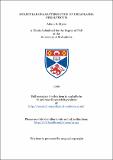Files in this item
Molecular characterisation of ureaplasma urealyticum
Item metadata
| dc.contributor.advisor | Thirkell, David | |
| dc.contributor.author | Myles, Alison D | |
| dc.coverage.spatial | 298 p. | en_US |
| dc.date.accessioned | 2018-06-18T08:26:32Z | |
| dc.date.available | 2018-06-18T08:26:32Z | |
| dc.date.issued | 1990 | |
| dc.identifier.uri | https://hdl.handle.net/10023/14145 | |
| dc.description.abstract | Monoclonal antibodies (Mabs) raised against Ureaptasma urealyticum (serotype 8) revealed the presence of three membrane antigens. One major surface antigen of apparent molecular mass 96 kDa, shown to express four distinct epitopes, was found to be serotype-8 specific. Thus, Mabs raised against this polypeptide will unequivocally differentiate serotype 8 from the other serotypes of human origin. The binding of antibodies to this polypeptide partially suppressed the growth of the organisms. Membrane expressed antigenic polypeptides of apparent molecular masses 16 kDa and 17 kDa were expressed by those serotypes belonging to the large serocluster (A), whereas the 17 kDa polypeptide only was expressed in the smaller serocluster (B). Using this Mab probe serotype 13 was placed in the larger serocluster.Thus,Mabs which recognise one or both of these polypeptides will unequivocally differentiate the two seroclusters of this organism. The cytosolic urease from U. urealyticum, serotype 8, was purified by immuno-affinity chromatography. Two active forms of the enzyme were demonstrated by non-denaturing electrophoretic analysis and a single peak with urease activity of apparent molecular mass 190 KDa was shown by FPLC. Freezing and thawing of the purified enzyme caused a partial breakdown to inactive sub-units whereas total inactivation of the enzyme and denaturation, achieved by boiling for two minutes in the absence of any added denaturing agents, revealed three subunit polypeptides of apparent molecular masses 72, 14 and 11 KDa. Densitometry suggested that the active enzyme contains equimolar ratios of the three subunits and hence is a hexamer. The active enzyme displayed two pH optima of 6.9 and 6.15. Mabs raised against purified urease bound to both the active enzyme and to the inactive 72 kDa subunit. No evidence of antigenicity was found for the 14 and 11 KDa sub-units. These Mabs cross-reacted with ureases from all the other human serotypes. Competition assays revealed a minimum of four and possibly five distinct epitopes on the enzyme, all distinct from its active site. Ureaplasmas from 5 animal hosts were studied using the various Mabs. The 96 kDa antigen was not found in any of the non-human strains. Variations in the available epitopes on the ureases and the presence or absence of the 16/17 KDa antigens in the non-human strains allowed a putative identification of the source of the non-human ureaplasmas. Such investigations also showed that with the exception of the 96 KDa serotype 8-specific antigen, chimpanzee isolates could not be differentiated from the human ureaplasma serotypes belonging to the large serocluster. These Mabs were also used to develop fluorescent probes and other diagnostic assays which included a slide agglutination system and a sensitive urease catch assay which was also converted into a 'dip-stick' assay. | en_US |
| dc.language.iso | en | en_US |
| dc.publisher | University of St Andrews | |
| dc.subject.lcc | QP801.U7M9 | |
| dc.subject.lcsh | Urea | en |
| dc.title | Molecular characterisation of ureaplasma urealyticum | en_US |
| dc.type | Thesis | en_US |
| dc.contributor.sponsor | British Technology Group | en_US |
| dc.type.qualificationlevel | Doctoral | en_US |
| dc.type.qualificationname | PhD Doctor of Philosophy | en_US |
| dc.publisher.institution | The University of St Andrews | en_US |
This item appears in the following Collection(s)
Items in the St Andrews Research Repository are protected by copyright, with all rights reserved, unless otherwise indicated.

